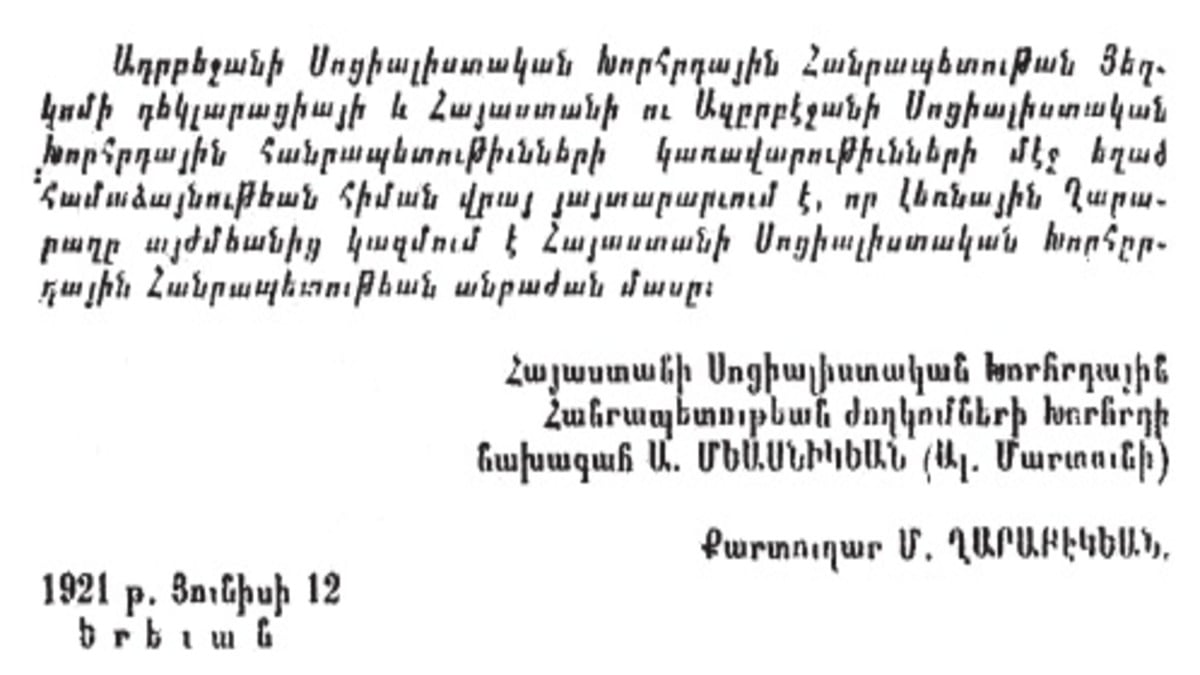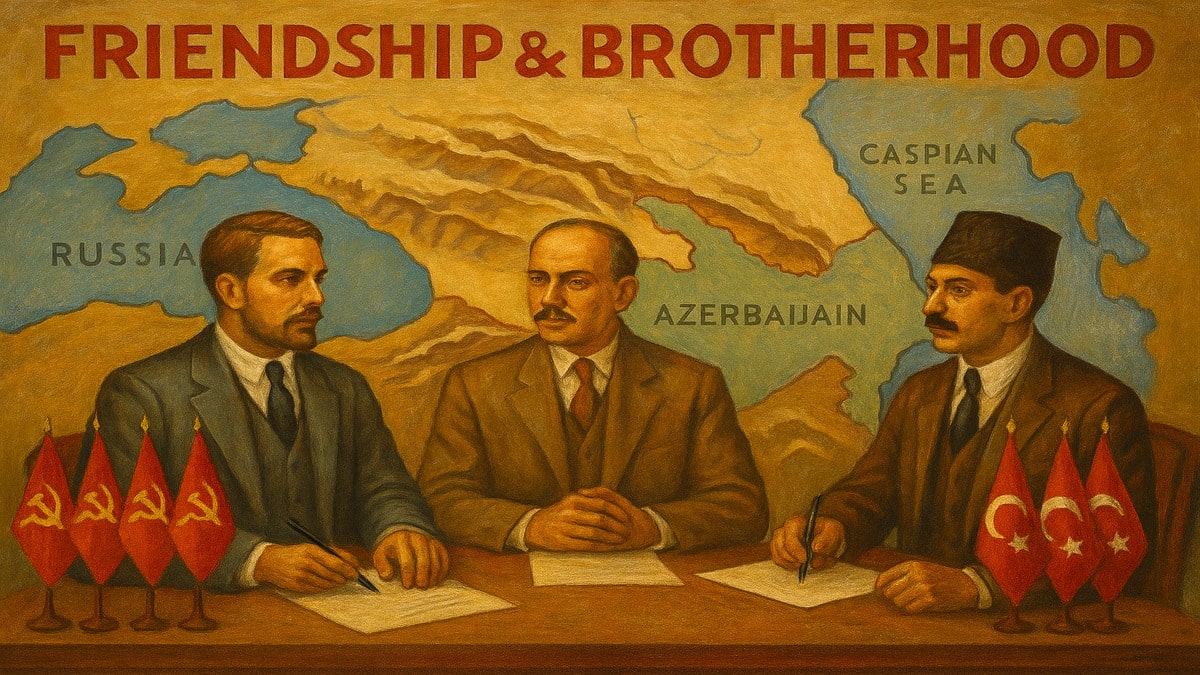
Appeal of the Karabakh Soldiers and Officers of the 2nd Regiment of the Armenian Army to the Government of Armenia Requesting Deployment to Karabakh to Counter Azerbaijani Aggression No. 57 — April 25, 1920
To the Honorable Minister of War and the General Commander of the Armed Forces of the Republic of Armenia
Standing firmly in defense of the shared national interests of the Republic of Armenia, fully aware of the dire situation in our dearly beloved Nagorno-Karabakh, and carefully considering the balance of forces across all fronts, we, the officers and soldiers of the 2nd Regiment, deem it unacceptable—and indeed criminal—to remain silent in the face of the suffering of our kin and compatriots.
Therefore, we respectfully urge the Government of Armenia to take the most decisive measures to end the bloodshed in Karabakh, or to promptly dispatch us to the theater of military operations in Karabakh, for which we are prepared to lay down our lives with honor.
Should the government find it impossible to deploy us as a unit of the regular army, we request the establishment of a clear protocol for selecting volunteers from our regiment, along with the provision of the necessary quantity of military supplies.
We await your urgent response.
Signed: The Karabakh Soldiers of the 2nd Regiment
By order of the Prime Minister, forwarded for disposition. Central State Historical Archive of Armenia, Fund 200, Inventory 1, File 566, Sheet 166. Certified copy. Typescript. Published in: Nagorno-Karabakh in 1918–1923, Yerevan, 1992, Document No. 295. (Emphasis ours – Y.B.)
Report of the Ministry of War of Armenia, Prepared at the Request of the American Consulate in Tiflis, Regarding Azerbaijani Military Operations in Karabakh in March–April 1920 No. 0150 — Erivan, April 27, 1920
- There are no official communications with Karabakh; therefore, the information provided herein is based on available intelligence reports.
- The situation in Karabakh is described as follows: Azerbaijan, in violation of the agreement previously concluded with the Karabakh National Council and seeking to fully subjugate the region, issued demands in mid-March for the disarmament of the population and recognition of Azerbaijani authority. Even prior to this, massacres of the Armenian population had occurred in Khankendi, Aghdam, and other locations where Azerbaijani forces designated for disarmament operations were stationed.
Distrusting Azerbaijani intentions, the local population refused to surrender their weapons and rose in rebellion on March 22, seizing Askeran. The garrisons in Shushi and Khankendi were surrounded by insurgents.
In response, the Tatars carried out a massacre in Shushi around March 24. Azerbaijani command began concentrating forces near Elizavetpol and in the Aghdam region. Simultaneously, on March 23, Azerbaijani regular units, supported by the Muslim population of the Akera River valley, launched an offensive against Zangezur. Despite initial success in the heights of Ayndag, Khanaga, and Gartyz, the attack was repelled, and the Tatars were pushed back to the left bank of the Akera River, near the village of Karalar and the heights of Tumaslu.
In the final days of March, Azerbaijan completed its troop concentration and initiated a simultaneous offensive in three directions:
- Along the highway toward Askeran–Shushi
- Toward the village of Vanklu (in Khachen) from Aghdam
- Toward the region of Karachinar–Erketch–Upper and Lower Agadjakend (Gulistan)
On April 3, after numerous failed assaults, the Tatars succeeded in capturing Askeran, thereby restoring Azerbaijani communication with the besieged garrisons in Shushi and Khankendi.
Beginning April 7, the Tatars, using Shushi as a base, advanced southward along the cart road toward Karyagino. By April 12, they had occupied a number of Armenian villages up to Keshishkend and Signakh, where their advance was halted. This movement was supported by an additional offensive toward the villages of Arakyul and Jeylan from the direction of Jebrail.
In Khachen, the Tatar offensive failed; they were unable to clear the area of Armenian settlements and resorted only to the destruction of villages in the river lowlands and the region northwest of Aghdam.
In contrast, in the Gulistan region, due to the significant forces deployed by Azerbaijan, all Armenian villages—including Azat in the west and Gulistan in the south—were completely destroyed. The population fled into the forests to escape total extermination. The following major Armenian villages were razed: Karachinar, Manas-Bek, Kharkhaput, Upper and Lower Agadjakend, Gulistan, Erketch, Karabulag, and others. The area west of Chaykend was spared only due to the failure of the Tatar offensive near Chaykend on April 11 or 12.
According to the latest reports, on April 16—after the cessation of hostilities—Azerbaijani forces attacked the villages of Abdal and Yengikend, southeast of Askeran; the attack was unsuccessful.
- The exact number of troops involved in the military operations on the Karabakh side cannot be determined due to the lack of reliable data.
Generally speaking, Karabakh possesses up to 30,000 armed men, along with a substantial stockpile of weapons, ammunition, and military equipment. These were acquired in 1918 from Russian troops retreating from the front, many of whom were influenced by Bolshevik ideology, as well as captured from Turkish forces in November of the same year. The Turks had dispatched a detachment to conquer Karabakh but were defeated in battle by the local population.
The defense of Karabakh has been organized locally, using the region’s own resources. From outside, only about 500 individuals—Karabakh natives, including refugees and former prisoners of war returning from Germany—arrived from Zangezur and other parts of Armenia. In early April, following the destruction of Shushi and several villages in eastern Jevanshir by Azerbaijani forces, these insurgents infiltrated the Shushi area in small groups.
To date, regular Armenian forces have not participated in military operations in Karabakh and remain stationed along its borders.
Reports in the press alleging that Commander Dro of the Eastern Group took part in the Karabakh uprising with regular troops are entirely inaccurate. Even at the time of Askeran’s capture by Azerbaijani forces—on April 3—Dro was in Erivan.
- As for Azerbaijan, according to available intelligence, the following regular units have been identified in Karabakh:
a) From the direction of Jebrail (toward Zangezur and later toward the villages of Arakyul and Jeylan):
- Elements of the 5th Baku and 7th Lankaran Infantry Regiments (formerly the Lankaran Reserve Battalion)
- 3rd Ganja Infantry Regiment
- 600 cavalrymen from the Kurdish Cavalry Division under Captain Selim Bek Sultanov
- Supported by four artillery pieces
b) From the direction of Aghdam (toward Shushi and Khachen):
- 1st Jevanshir Infantry Regiment
- Elements of the 3rd Ganja Infantry Regiment
- Likely the 1st Tatar and 2nd Karabakh Cavalry Regiments
- Supported by 8–10 artillery pieces
c) Against Armenian villages in the Gulistan region:
- Elements of the 5th Baku Infantry Regiment
- Elements of the 3rd Ganja Infantry Regiment
- 3rd Sheki Cavalry Regiment (transferred toward Shushi on April 11)
- With artillery support
Total forces deployed:
- 4 infantry regiments
- 3 cavalry regiments
- Kurdish Cavalry Division under Captain Sultanov
- 4–5 artillery batteries
Although Azerbaijani regiments typically had low troop numbers, their strength was significantly increased during the Karabakh campaign. Thus, the total number of regular Azerbaijani troops can be estimated at a minimum of 8,000 rifles and 2,000 sabers. The number of locally organized fighters and volunteers was substantial and cannot be precisely calculated.
More than half of the Azerbaijani army was deployed to Karabakh. Azerbaijan feared a potential Armenian offensive from the Dilijan–Kazakh region but lacked the capacity to secure it with regular troops. As a result, the local population in that area was mobilized.
While conducting demonstrative offensives against Armenian villages in the Kot-Kend and Shamshadin districts, and accusing Armenians before the Allied powers of attacking Tatar villages, the Azerbaijani government succeeded in deterring the Armenian government from exploiting its otherwise advantageous position in the region.
Colonel of the General Staff* Colonel of the General Staff* Acting Quartermaster General* Staff Captain
Resolution: To the Minister of Foreign Affairs. Confidential. By order of the Commander of the Armed Forces, forwarded for information. A copy of this report was sent by the Minister of War to Captain Fletcher at his request.
Acting Chief of Staff of the Commander of the Armed Forces Colonel of the General Staff* Acting Quartermaster General, Staff Captain*
Central State Historical Archive of Armenia, Fund 200, Inventory 1, File 563, Sheets 173–174 verso. Original. Typescript. Published in: Nagorno-Karabakh in 1918–1923, Yerevan, 1992, Document No. 297. (Emphasis ours – Y.B.) *Signatures illegible. РАЗДЕЛ VI
Yuri Barsegov “Nagorno-Karabakh in International Law and Global Politics”
Artatsolum
Read Also:
- Ancient and Medieval Sources on Artsakh (Karabakh) as Part of Armenia’s State Territory
- Message from Gandzasar Catholicos Esayi to Peter I August 10, 1716
- Memorandum Issued to Ivan Karapet Along with the Imperial Letter to the Armenian People Regarding Russia’s Readiness to Take the Armenians of Karabakh Under Its Protection June 3, 1723
- Decree of Peter I to the Armenian People Regarding Russia’s Willingness to Offer Protection to the Armenians of Karabakh
- On Armenian Hopes for Russian Assistance
- Report of Minas Vardapet to Peter I
- Contents of the Secret Letters from the Armenian Assembly and the Armenian Army of Karabakh to the Russian Emperor and Chancellor August 1724
- Contents of the Secret Letters from the Armenian Assembly and the Armenian Army of Karabakh to the Russian Emperor and Chancellor August 1724
- State Charter of Peter I On the Acceptance of the Armenian People Under the Protection of the Russian State and Their Resettlement from Karabakh to Newly Acquired Persian Provinces November 10, 1724
- Letters from the Catholicos and the Meliks of Karabakh
- Charter of Catherine I Addressed to the Armenian Assembly
- Message General Mkhitar—to the Russian Government
- The Armenian Assembly’s Request for Military Assistance June 19, 1727
- Result from Russia’s failure to fulfill its promises of assistance to the Armenians March 1736
- On the Issuance of the Decree Appointing Panah Khan
- Letter from General Potemkin to Prince Argutinsky with questions about the liberation of Armenia
- Appeal of Gandzasar Catholicos Hovhannes to Catherine II
- Letter from Melik Apov Iosifov to Provide Assistance to Russian Military Forces for the Liberation of Enslaved Karabakh
- Report of Prince G. Potemkin to Catherine II
- Request of General P. Potemkin to Prince G. Potemkin
- Letter from Archbishop Joseph Argutinsky to General P. Potemkin
- Memorandum to Catherine II on the Project for the Restoration of the Armenian Kingdom
- Decree of Paul I to General Count I. Gudovich
- Letter from Archbishop Joseph Argutinsky
- Report by State Councillor P. Kovalesky
- The Khan’s Vizier, Mirza Jamal Javanshir Karabakhsky
- From the Report of General Marquis Palluci to Alexander I
- The Gulistan Treaty – An Interstate Act of Iran’s Cession of the Karabakh Territory to Russia
- Report of General A. Yermolov to Alexander I Requesting the Waiver of Tax Arrears for the Karabakh Khanate
- LETTER FROM GENERAL A. YERMOLOV TO MEHTI-KULI KHAN
- Directive from General A. Yermolov to General I. Velyaminov
- Letter of Metropolitan Sarkis Hasan-Jalalyan To General A. Yermolov
- Letter from General I. Paskevich
- TREATY CONCLUDED BETWEEN RUSSIA AND PERSIA AT TURKMENCHAY
- Russian Military Historian V. Potto on the Essence of the Treaty of Turkmenchay
- Order of General I. Paskevich to Colonel L. Lazarev
- STATEMENT ON THE DIFFERING ATTITUDES OF ARMENIANS AND TATARS TOWARD THE ANNEXATION OF KARABAKH TO RUSSIA
- REPORT By the Acting Uezd Chief of the Dzhevanshir Uezd, D. Baranovsky
- From the Memoirs of a Member of the Russian National Council in Baku (1918–1919)
- “TREATY OF PEACE AND FRIENDSHIP” Between the Ottoman Empire and the Republic of Armenia
- Letter from A. Mikaelyan, Representative of the Karabakh and Zangezur Fellowship
- Note of Protest from the Ministry of Foreign Affairs of the Republic of Armenia
- Appeal of the Karabakh Armenian National Council To the Commander of Allied Forces in Baku
- LETTER FROM THE CHAIRMAN OF THE KARABAKH ARMENIAN NATIONAL COUNCIL
- Turks in Shushi
- Letter of Welcome from the Karabakh Armenian
- LETTER FROM GENERAL BAGRATUNI
- FROM THE MESSAGE OF THE ARMENIAN TELEGRAPH AGENCY
- REPORT FROM THE DIPLOMATIC REPRESENTATIVE OF ARMENIA IN GEORGIA
- Resolution of the Fifth Congress of Armenians of Karabakh
- Report by Prime Minister Hatisov to the Council of Ministers of Armenia
- FROM THE MEMORANDUM OF THE KARABAKH ARMENIAN NATIONAL COUNCIL
- 🇬🇧 ANNOUNCEMENT OF THE BRITISH MILITARY MISSION IN SHUSHA
- From the Memorandum of the Armenian Representative to the British Military Mission in Shusha
- Report from the Office of the Governor-General of Karabakh
- NOTICE FROM THE REPRESENTATIVE OF THE BRITISH MILITARY MISSION IN SHUSHI
- 🇬🇧 Doubts Expressed by British Delegate Eric Forbes Adam
- LETTER FROM THE ARMENIAN DIPLOMATIC REPRESENTATIVE
- Assessment by the Karabakh Armenian National Council
- “The Caucasian Word” on the Confirmation by a British Command Representative
- Letter from the Acting Governor-General of Karabakh
- OVERVIEW OF THE SITUATION IN THE CAUCASUS
- Proclamation of the Zangezur Armenian National Council
- Telegram from the Prime Minister of Armenia to the British High Commissioner
- MESSAGE TO THE DIPLOMATIC REPRESENTATIVE
- Photographic Evidence of the Annihilation of Shushi’s Thirty-Thousand Strong Armenian Population


